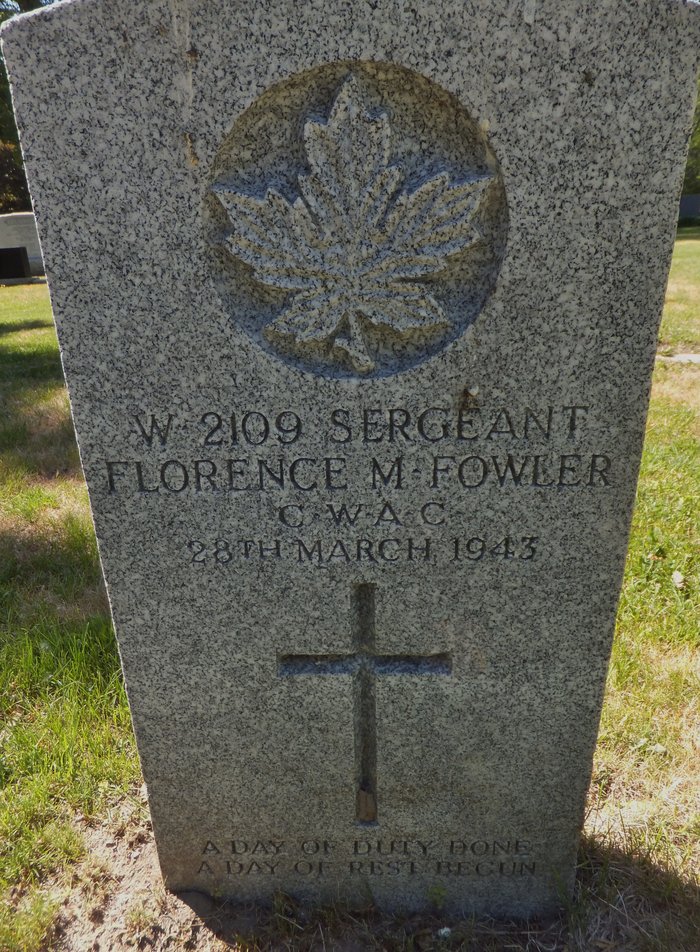
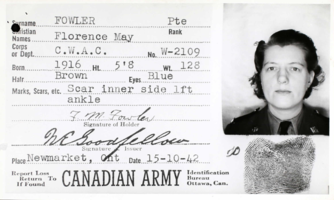
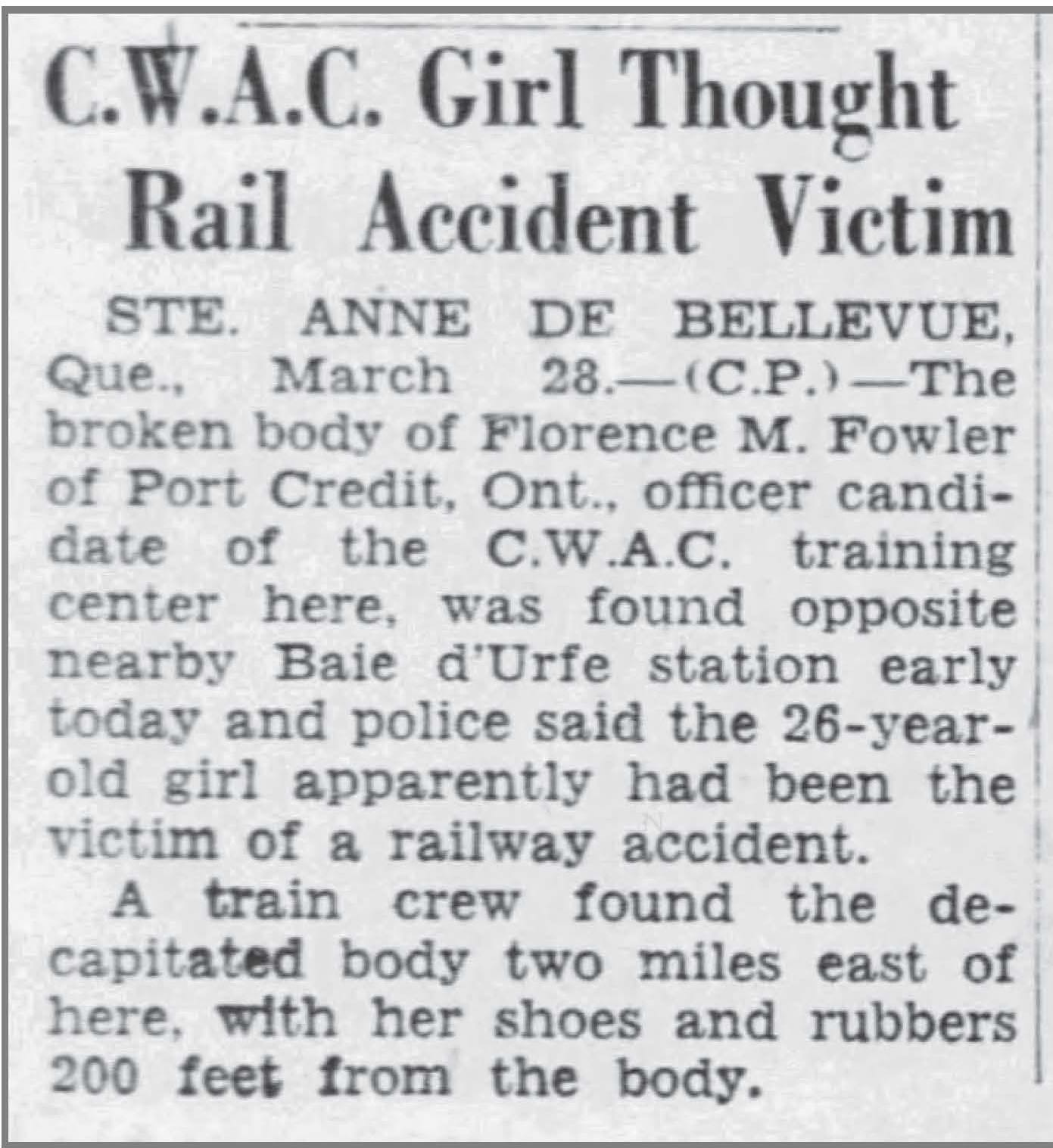
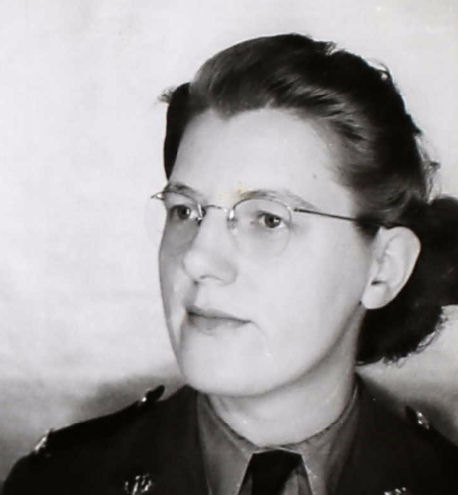
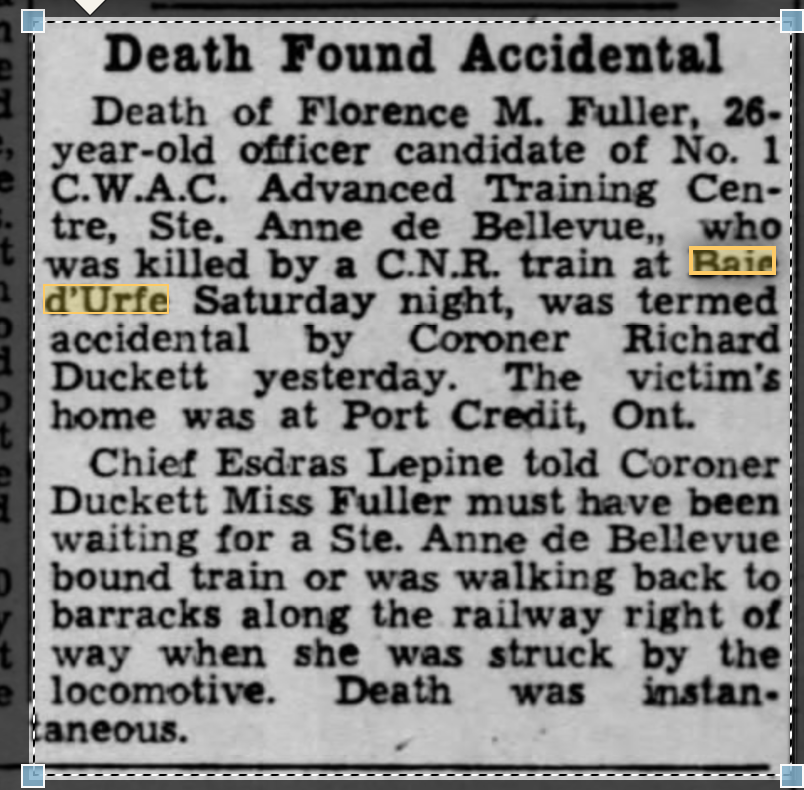
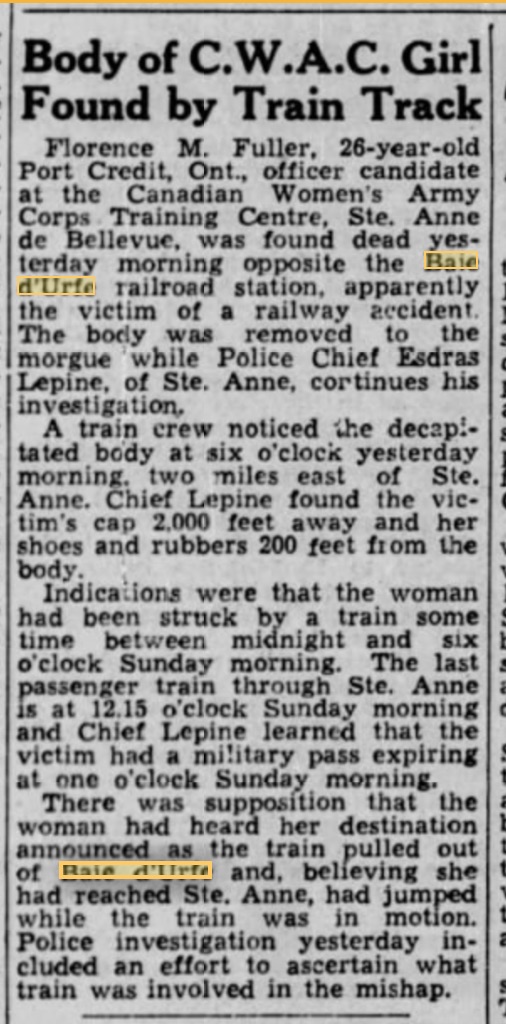
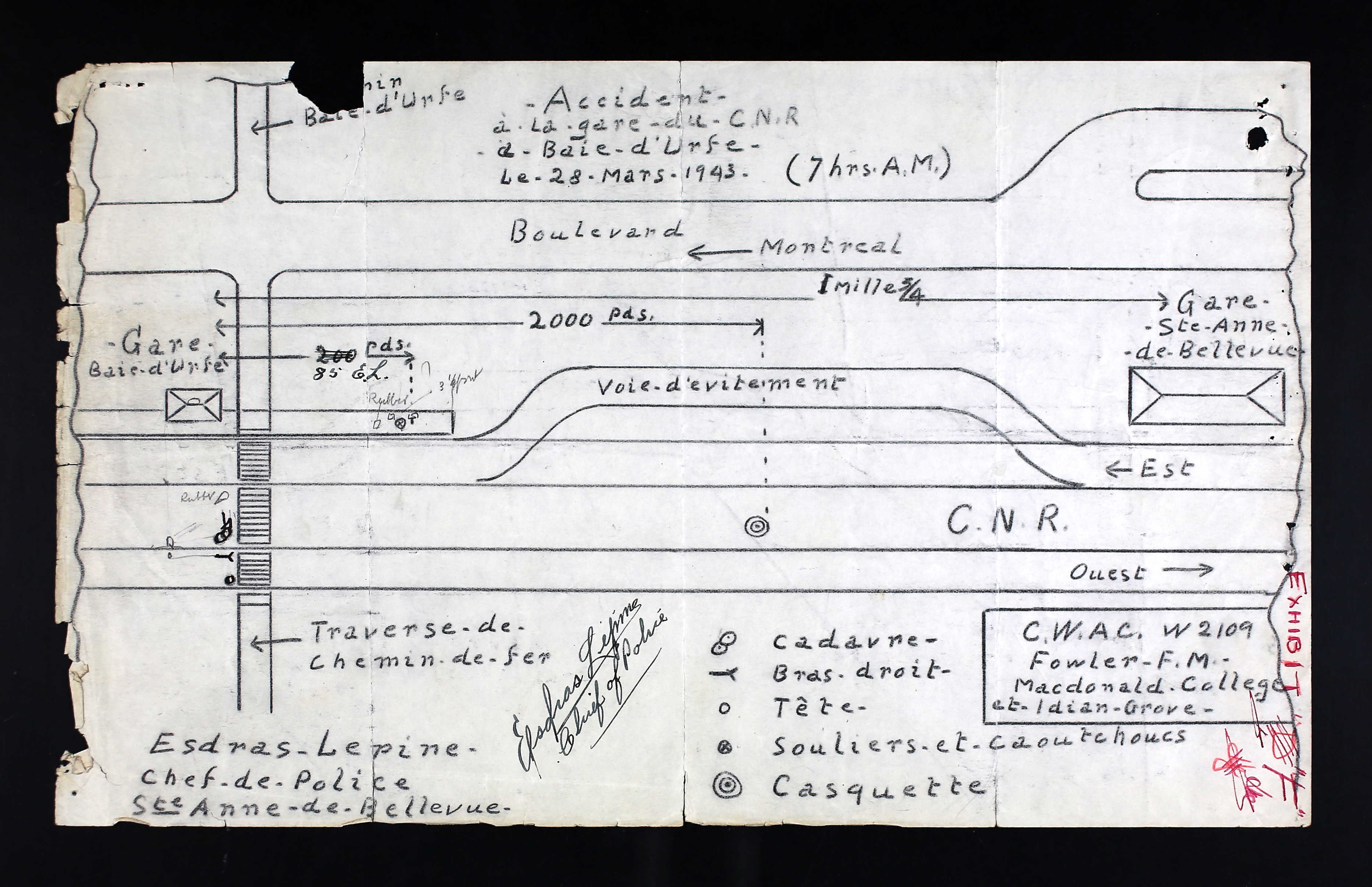
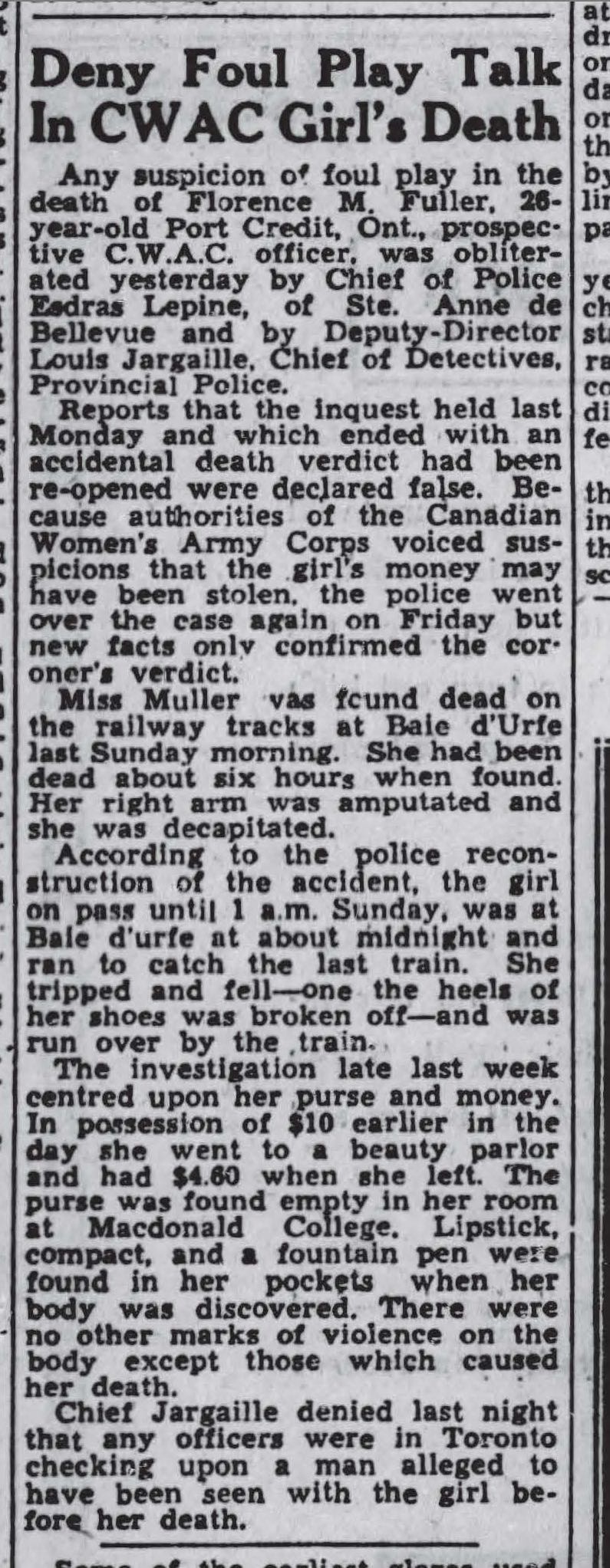

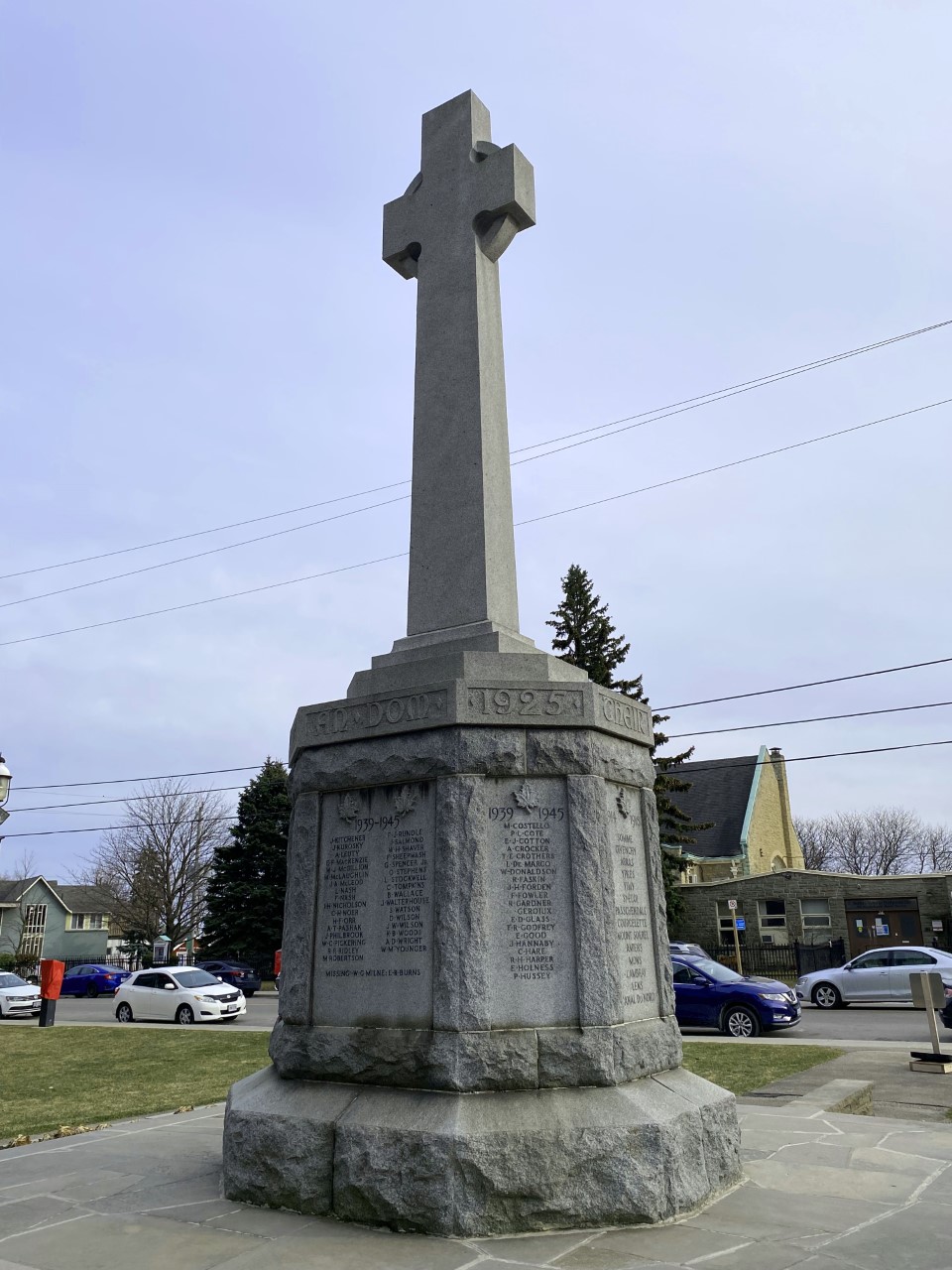
November 20, 1916 - March 28, 1943










Florence May Fowler was the second oldest child of Esau (1880-1950) and Alice (nee Robertson) Fowler (1886-1967) of Indian Grove, Port Credit, Ontario, present day Mississauga. Florence had three sisters, Mrs. Grace Agnes (nee Fowler) Patchett (1914-1956), Ivy Dorothy Fowler (1921-2007), and Lillian Minnie (nee Fowler) Vance (1924-?), and one brother, Charles James Fowler (circa 1920 - 1993), who enlisted in the Canadian Army. The family was Baptist. Mr. Fowler worked at the St. Lawrence Starch Company, then during the war, for the Fall Arms Company. Mrs. Fowler worked as a cook at the Mississauga Golf and Country Club.
Florence stood 5' 8" tall, weighed 128 pounds, had blue eyes and brown hair. She had a scar on the inner side of her left ankle. In 1928, she had an ear infection requiring a mastoidectomy.
Florence enjoyed skating, swimming, and baseball. She liked to read biographies. She was a member of the Young People's Organization. At No. 23 BTC: "Education: Grade VIII, led class in final year -- age 13 years. Occupations: domestic and store clerk intermittedly for five years, domestic rest of time. "Cpl Fowler possesses a great deal of native ability and works hard. From personal observation, I have had an opportunity of watching her rise from a competent typist to an excellent NCO and take charge of the office routine and administration. She has at the same time been acting as corporal on CWAC strength -- acting NCO over the CWAC at this Centre. She seems excellent officer material." Lt. J. K. McEwan, January 21, 1943. After the war, Florence wanted to do bookkeeping and typing.
On her PERSONNEL SELECTION RECORD, dated March 9, 1943, Capt. Verity Mitchell Ross reported: "Commenced school between 5 and 6 years of age. Never repeated or skipped a grade. Found composition difficult; also subjects which required a use of it. Passed HIGH SCHOOL ENTRANCE requirements (Ont.) Left school at 13 years of age to become self-supporting. Domestic for 12 years. Changed positions at intervals to improve her economic status. Just prior to enlistment was a parlour-maid. Enlisted November 10, 1941, Toronto, Ontario. Attested December 12, 1941. BASIC TRAINING: University Armouries, Toronto, December 1941. Detailed to Newmarket, Ontario, January 15, 1942 and remained there until despatch for OTC. Was employed as waitress in Officers' Mess from January to September 1942. During this period, taught herself typing. Promoted to rank of Cpl on CWAC establishment. Clerk Typist - D. P. Selection, October 1942 to January 1943. Received Group C Trades Pay. OTC, CWAC (A) Training Centre No. 1, February 4 - April 2, 1943. PERSONAL HISTORY AND APPRAISAL: Cadet Fowler was born at North Bay, Ontario. Her parents are living. Her father is employed in a munitions plant. She has one brother and three sisters...relations at home appear always to have been satisfactory. Her family approved of her enlistment, and are proud of her military activities. Civil status: single...She wears glasses...and is of rather warm colouring. General appearance is average. According to reports received from the Directorate of Personnel Selection, her work, when employed with the Army Examiner at Newmarket, was regarded as highly satisfactory. At the time of this interview, Cadet Fowler appeared extremely tired, worried, and somewhat depressed. She finds the O. T. C. extremely difficult and has worried considerably concerning her progress, and feels that she has not the academic background necessary to deal with the Officers' Training curriculum. She particularly finds it difficult to express her thoughts in written form. She seems to spend all her time studying and has apparently not mixed much with the other members of her class. One feels that she has inferiority feelings concerning her academic achievement. Her M Test score is below that usually expected of Officer candidates, but is slighly above the average of CWAC personnel in general. Her CAC Test score fulfills requirements for Officer candidates. On the basis of her performance on these two tests, one would judge that she has sufficient general ability to cope with Officer Training Course fairly well, provided she applies herself to the work under consideration. She appears to be a conscientious, dependable type of person. Her reactions generally, apart from those concerned with reference to her work at the ATC suggest that she is fairly well poised and fairly well adjusted. Before leaving the A. E.'s office, she was encouraged to return to discuss her difficulties at her leisure and that in no instance, was it necessary for her to be paraded...her Platoon Commander mentioned....that Fowler required a good deal of encouragement and understanding...and that while her marks had not been good, they were just about average, and that she was worrying unduly."
On March 10, 1943: "The undersigned (Ross) Army Examiner summoned Cadet Fowler to her office on the above-mentioned date and reassured her that her progress was satisfactory and that if it continued along such lines, she need not worry. She appeared very much relieved and left the office in a much happier frame of mind."
On March 19, 1943: "Cadet Fowler was again interviewed...as a therapeutic measure and it was during this interview that she informed this Army Examiner that the had requested permission to repeat OTC. When questioned with reference to her reasons for making this request she states that she still lacked self-confidence and that she felt that repetition would help her to attain the confidence and poise she so badly needed."
On March 23, 1943: "She came to the undersigned of her own accord, on this date, to report that repetition of the OTC was beneficial to her. At this time, she appeared lighter in spirit than hitherto, and much better poised." Capt. Verity Ross dated the follow up report March 29, 1943.
On March 28, 1943, Sergeant Florence May Fowler died at Baie-d'Urfe, Quebec, south of Montreal. A Court of Inquiry was struck the next day at St. Anne de Bellevue, Quebec to investigate the circumstances of her death.
The first witness, Lt. K. M. Belcher, CWAC, the Adjutant of No. 1 CWAC (A) Training Centre stated that W2019 Florence May Fowler was enrolled in an Officer Training Course at Ste-Anne-de-Bellevue, Quebec.
The second witness, Lt. Geraldine O'Meara, Officer Instructor, stated: "On the 4th of February, the deceased was posted to my platoon as a cadet. The progress made by the deceased was normal. About the 8th or 9th of March, the deceased was paraded to me and requested to be deferred as she was apprehensive as to her ability to complete the course satisfactorily with her class. Insofar as her work was concerned, I would not have considered her deferment necessary, but after consulation with my assistant instructors, with Capt. Royal, commanding Cadet Wing, and with the Army Examiner, Captain Ross, it was decided that the deceased should be deferred at her own request and transferred to the next class. On the occasion of the transfer, she appeared to be relieved by the decision and showed no sign of resentment. In my opinion, the deceased suffered from a sense of inferiority in the presence of other cadets or superior education. I attribute this in part to her having been employed for 12 years as a domestic servant."
The third witness, Captain V. M. Ross, Army Examiner produced the document noted above, dated March 29, 1943. When asked about her opinion of Cadet Fowler, she stated: "She seemed much happier about the deferment. On the 23rd of March, the deceased reported to me of her own accord and I was satisfied with the manner in which she was adjusting herself. She definitely did not exhibit any indication of suicidal tendency."
Lt. Col. H. W. Johnston, GSO at Headquarters MD 4 stated: "On the 29th of March, I was detailed as President of a Court of Inquiry in connection with the death of the deceased....I attended the Coroner's Inquest with respect to the deceased....the deceased died a violent death; that this death was not imputable to the crime of whomsoever, neither to the negligence of anybody; that no crime accompanied or preceded this death, and there was no necessity to hold an inquest before a jury. In consequence, a verdict of an accidental death was rendered."
Cadet A. Hawkins, W.11262, the fifth witness, stated: "I first met the deceased when she was posted to the same platoon as myself a few days after I arrived at the Training Centre on the 11th of March. The deceased was a quiet girl and was well liked in the platoon. On the 22nd of March, the deceased came to my room and said that she had to move out of the room she was then occupying and asked if I and my friends would mind if she joined us. We discussed the matter in a joking manner for 15 to 20 minutes and the deceased seemed in high spirits. Later, the deceased returned and said that Sgt. Pat Buttle had asked her to go into another room and that she felt that although she would have like to have stayed with us, she should fall in with Sgt. Buttle's suggestion. I last saw the deceased alive on Saturday evening at approximately 1830 hours on the Ste. Anne's Road just west of the intersection with Maple Street. She was proceeding west. I knew what time it was by checking what time I left the Training Centre, Sir, which was 1834 hours. She seemed in perfectly normal spirits, Sir. I could not say if she was carrying her satchel."
Cadet N. S. Kane, CWAC, W.3178, the sixth witness stated: "I first met the deceased when she was posted to the platoon in which I am, about the 12th of 13th of March. I did not see much of her until one night she came into our room and said that she was being moved and asked if she could join us. She seemed very cheerful and jolly and brought some candy with her, and we talked for awhile and later she told us that she was not coming to our room as she was being placed elsewhere. I last saw her about 6 o'clock on Saturday, the 27th, going east on Ste. Anne's Road near the corner of Maple Avenue. She appeared in good spirits. I do not remember if she was carrying her satchel and I do not remember if she had any parcels. I want to add that the deceased had apparently just had her hair done. I presume she had just come from the beauty parlour."
Cadet C. Mann, W.2029, was the seventh witness. "I joined the CWAC about three weeks before the deceased. We were trained together at the University Street Armouries in Toronto and subsequently, we were both posted to No. 23 BTC for duty. I saw the deceased quite frequently and she impressed me as a conscientious girl who took her duties seriously. At time, I think she felt that she had not the educational advantages that some other girls had. She was working hard to improve herself. Her attitude appeared to be a normal, healthy, cheerful one. When I left No. 23 BTC, the deceased remained behind. I met her again when she came down to this Training Centre to take the Cadet Course. I was away from the Training Centre on special assignment for some weeks and then returned to the Training Centre to take a special Cadet Course and found, on my arrival, that the deceased had been deferred and posted to the Cadet Course which had just started. She informed me that this had been done at her request and tht she appreciated having been allowed to repeat her first month and she now felt that she was making satisfactory progress. Two weeks later, she was still satisfied that she was making good progress." When asked if Fowler had any indication of suidical thoughts, Cadet Mann answered, "Oh, no, Sir." Mann mentioned that the last time she had seen Fowler was on "Wednesday evening, the 24th. The deceased came to my room and asked me to help her with the solution of a problem. I did so and she seemed quite interested and satisfied. I saw her again for a moment on the morning of Thursday, the 25th."
The eighth witness, Sgt. R. K. Soper, an NCO on the A & T Staff at No. 1 CWAC (A) TC: "On 27th March, at 1500 hours, I was NCO on gate duty. The deceased checked out at 1517 hours. She said that she was going to Ste. Anne's and that she had a late pass until 1 o'clock. She had the pass in her hand but as she said she was going to Ste. Anne's, I did not examine it. I did not see the deceased again until sometime between 1745 ad 1830 hours when I was checking out a number of NCOs and Cadets. A girl spoke to me and said, 'You checked me out at about 3:15. I came back and I knew I was going out again so I didn't bother checking in.' To the best of my knowledge and belief, the girl was the deceased, but as I was very busy and had a number of NCOs and Cadets around the desk, I did not notice her particularly. As far as I can recollect, she was wearing her greatcoat and cap at the time. I did not see the deceased again at any time before her death."
Cadet E. M. Crooker, W.10558, CWAC was the ninth witness. She stated: "I first met the deceased after I arrived at Ste. Anne de Bellevue on the 11th of March. I talked to her on two or three occasions and she appeared somewhat worried about the progress she was making. The last time that I spoke to her was on Monday or Tuesday and she appeared to be depressed following the examination on Saturday, the 20th. I suggested to her that it might help her to study with someone else and she thought that it would be a good idea. I spoke to hear again the following night and said, 'We didn't get around to it.' and said, 'Yes.' She seemed somewhat more cheerful. I met her in class but did not hold any protracted conversation with her. The deceased was rooming in another room other than mine."
The tenth witness, Company Sergeant Major C. D. Stewart, W2056, stated: "I first met the deceased when she was with Toronto Company, later she was moved to Newmarket and in the course of visit to that place, I saw her on several occasions. I again met her when she was attending the Cadet Course here. I spoke to her on or about the 15th of March and at that time, she was worried about the progress she was making with her studies. I endeavoured to cheer her up with some success. I saw her on parade on several occasions but did not speak to her."
The eleventh witness, W.10042, Cadet M. Adams, CWAC stated: "I met the deceased shortly after my arrival here on March 11th. On Monday, 22nd, the deceased was moved into my room. We had several conversations together. She seemed a quiet girl much interested in her studies and did not discuss her home life or private affairs. I do not know if she had any male friends or if she had made any friends in Ste. Anne de Bellevue or Montreal. On Saturday, March 27th, the deceased went out saying she was going to the hairdressers. I suggested to her that we might go out together and she said that she might do so after supper. I did not see her again, she did not sit at our table at supper and I did not notice her in the room. After supper, I went into the 'Silence' room across the hall to study and returned to my room a little before 7 o'clock. I went to Ste. Anne's and spent the evening with Cadet Leckie at the Canada House. I did not see the deceased during the evening. At 11.30, Cadet Leckie and I returned to our room, the deceased had not come in. About 1 o'clock, Cadet Watt came in from Montreal. The remaining occupant of the room did not return until the following day." When questioned about Florence's satchel, Cadet Adams replied, "I could not say if she took her satchel to the hairdresser's. But it was hanging in her cupboard the next day. I remember that on Saturday, the 27th, the deceased received a letter which must have been a long one, as she opened it and stood for some time in the middle of the floor reading it."
The twelfth witness, Miss Paulette Cousineau, stated: "The deceased called by telephone at 1 pm Saturday March 27, while I was at lunch and made an appointment for a perm at 3:30 pm. At 3:30 pm, she arrived and I asked her how she wanted her hair done and she discussed the matter and then decided to have it cut short. My father came up from downstairs to cut her hair. During the afternoon, she was quiet and said very little. I remember she asked me what time the picture show in Ste. Anne's started on Saturday night. When her hair was finished, she was pleased with it, admiring the back and said that it would save her a lot of trouble in the mornings. She said she would come back for a set in a week or so. She paid me with a $10 bill and I gave her 60 cents and $4 change -- a $2.00 bill and two $1.00 bills. She took her money from a wallet with a zipper." When asked about a satchel, Miss Cousineau replied, "It was a wallet and not a satchel. I did not notice if she carried a satchel."
The thirteenth witness, Mrs. Rose Duguette, Ste. Anne's stated: "On Friday night, the deceased called for her laundry. I told her that I would be unable to do any more laundry for the CWAC girls. She told me that she was repeating one month of her course and instead of leaving next Friday, would be here for another month and coaxed me to continue doing her laundry. I explained I could not make up an exception of one. She asked me if there were any hairdressers in the town and I told her of Miss Cousineau. She returned on Saturday, after lunch, with Cadet Muir's laundry in her haversack. She chatted about her laundry during the next month and said she would be back next week to see if she could not persuade me to take it. She also asked how good the hairdresser was and where she could buy some wide elastic as she had just bought a brassiere (she had it in a small parcel with her) which was too small for her. She only had her haversack on her back."
The fourteenth witness, Cadet V. Leckie, stated: "I last saw the deceased at a quarter to three on Saturday, 27th, when she went out, having said earlier that she had an appointment at the hairdresser's. We asked her if she would go out with us in the evening and she said that she would see. I did not see her again. Between 3 o'clock and 5:30 pm, I was in the room most of the time except about 4:30 when I took a bath, after which I went to supper at 5:30. Afterwards, I went to the laundry to finish some ironing. I went out again at 8 o'clock and came back at 11:30 pm. There was no sign of the deceased at that time. The deceased was a quiet girl and reticent, at no time did she discuss her home life or private affairs. I do not know if she had made any friends at Ste. Anne de Bellevue, or if she had any male friends."
W2029, Cadet C. Mann, CWAC stated, "I boarded the train which is scheduled to leave Montreal at 11.30. I got on fairly early through the rear car. I saw two or three CWAC personnel whom I did not know, the deceased was not one of them. I found a seat in the second car from the engine of the train and rode until nearing Beaconsfield. Before the train left Montreal, about nine or ten CWAC personnel passed through the car to the car in front, amongst them being Cadets Watt, the Dupuis sisters, and Herzer. The deceased was not amongst them. I recall distinctly that the train stopped at Beaconsfield. It stopped again to take on water just before leaving Ste. Anne's. My impression is that after leaving Beaconsfield, the train stopped for a few minutes shortly before reaching the water tank. At Ste. Anne's, I disembarked between the two forward cars and waited for the other cadets to get off. I did not notice who got off the rear car. I did not see the deceased in the vicinity of the station."
The fifteen witness, Lt. M. J. Flett, stated: "I am a platoon commander at No. 1 CWAC (A) TC. The deceased was posted to my platoon on 15 March. She was a quiet girl and her progress was average. She did not appear to be worried. She never discussed with me any details of her home life or private affairs. I am not aware that she made any friends in Ste. Anne's. I do not know if she had any male friends. I last saw her on parade the morning of Saturday, 27th of March. I went on weekend leave myself and I did not see the deceased again."
The sixteenth witness, Cadet B. E. Russell, W.12199, stated: "I first met the deceased on the 15th of March when she moved into our room. I talked to her from time to time but she never spoke about her home life or private affairs. I do not know if she had any friends in Ste. Anne's, particulary any male friends. I last saw the deceased about lunch time, Saturday, 27th."
Cadet I. V. Watt, W.2382, was the seventeenth witness. "I first met the deceased about the 15th or 16th of March when she was posted to our platoon. About Monday, 22nd March, she was moved into our room. I talked to her quite often as I found that she had been at No. 23 Basic Training Centre at Newmarket. I talked to her about a girl whom we both had known there. We got on well together but she never discussed her home life or private affairs. I do not know whether she had any male friends. She once told me that she had only been to Montreal once, during the first week that she was at the Training Centre. I last saw her about 1 o'clock on Saturday 27th March. As I knew she had a pass to go to Montreal, I asked her if she was going there and she said she did not think so, but gave no reason for not going. She seemed quite cheerful. I do not think that she had any suicidal tendency. The only time I ever heard her express discontent was once when I referred to our mutual friend at Newmarket who had gone overseas. The deceased said that she would be just as glad to get out of Ste. Anne as her friend had been to get out of Newmarket. I went to Montreal on the 1.23 pm train, CNR, and returned on the CNR train which leaves Montreal at 11.25 pm. I got on at the rear of the train with four others: Cadets F. Dupuis, P. Dupuis (sisters), D. Herzer, and Y. Talbot. The train was due to leave in about 5 minutes, we walked through the two rear cars and found seats in the front of the car, together, nearest the engine. I did not see the deceased in any of the rear cars. When we got off at Ste. Anne's, there were quite a number of CWAC personnel but I did not see the deceased amongst them." Watt was asked if the train stopped at Baie d'Urfe. "I think that it did. The train seemed to stop and then a short distance further we stopped at the water tank before reaching Ste. Anne's station. I remember the train stopped at Beaconsfield. I am not sure whether it stopped at Pointe Claire or at Beaurepaire." She added, "I did not go back through the train at any time, so I cannot say whether the deceased boarded the train after I got on. When I arrived at Barracks, I went up to my room, the lights were not on and I could not see whether the deceased had come in. In the morning, her bed was just as she had made it the day before. I thought nothing of this as I believed her to have a weekend pass.
The Quartermaster of the training centre was the next witness and he identified the list of personal effects belonging to Cadet F. M. Fowler.
Anastas Sakelaris of Ste. Anne de Bellevue, the nineteenth witness, stated, "On Sunday morning last, at about 11 o'clock, Herbert Norwood came into my restaurant alone, bought cigarettes and asked me if I had heard about the accident. 'Which accident,' I said. He replied, 'A CWAC girl got killed.' Later on, about 11.30, when Constable Brunet walked in, I told him to see Norwood about the accident." When asked by Lt. M. Lois Stitt of the Court of Inquiry, "When did the girls come in?" Sakelaris replied, "About 10.30. Then Norwood sat with them. When he bought cigarettes, he paid with a two dollar bill. I have known him for a long time when he was a Provost and he was always broke. I even had to hand him money. Saturday night, he came in after the Canada Hotel closed its doors, which was about 12 midnight." When asked by Stitt who paid the bill when Norwood was with the girls, Sakelaris stated, "I think it was about 60 cents and he paid with a $1.00 bill. He went to Canada Hotel on Saturday night, I believe. He was here Saturday night early, drank and ate, then went out again between 7 and 7.30, paid with small change and came back after 12. Sunday morning, he was feeling particularly sad and worn out."
Brakeman Paul Henry Veilleux stated: "On Sunday, March 28, 1943, I was headend man on Extra 6189 East, Engineer Silverthorne, Conductor F. Thompson. We took the eastward passing siding at Ste. Anne's to clear train No. 18 and had a message to call the Despatcher as soon as this train had cleared. Our engine was stopped about 300 feet from the shelter at Baie d'Urfe, and as soon as Train No. 18 cleared, I walked to the shelter where the Despatcher's telephone is located and received instructions from the Despatcher on duty to follow No. 18. It was then approximately 6.15 am, It was still dark. After receiving instructions from the Despatcher, I walked out and stood in the eight foot between the eastward and westward main tracks, facing north and by using a red fuse, signalled to my Engineer to proceed and while giving this signal, noticed a head in between the rails of the westward track. My Engineer had started to pull ahead bu this time and I immediately gave the stop signal which he acknowledged. I ran back to the engine and advised Engineer Silverthorne and we both proceeded back to the spot where we also found the body of a girl in the eight foot just clear of the south rail of the westward track. The body, which was just south of the sough rail was about opposite the head which was just inside the north rail of the same track and directly in front of the Baie d'Urfe shelter. The body was on its back with the shoulders towards the east, and right arm, which had been completely severed, was just inside the south rail of the westward track. It appeared that this girl had been struck and thrown. Her clothing did not have the appearnace of her body having been rolled or dragged. Her overcoat was turned up over the shoulders. She was fully clothed and I particularly noticed her stocking, which were of a light colour, were not torn or damaged in any way. On making further examination, while accompanied by Engineer Silverthorne, I also found her shoes and rubbers were on the platform on the shelter side and about 60 feet west of the body. The shoes were the ordinary low type worn by ladies and were unlaced and separated from the rubbers. They were scattered around within a radious of 15 to 20 feet. I noticed the left shoe was damaged, the upper portion being torn from the sole on the inside, just back of the instep head. There was no hat around, not where the body was. I noticed the girl had a short hair cut with the hair curled and it was not disarranged. It was dark and as we have been instructed by the Despatcher to move away, we did not make a further examination but from my casual examination with the light afforded by my fuses, I particularly noticed the absence of blood opposite where the shoes and rubbers were. I did notice that where the members had been severed, there was a slight discolouration which to my mind, indicated the mishap had occurred sometime previously. We had been standing into clear on the passing track for about ten minutes. Our headlight was turned off. The headlight was burning full on Train No. 18 as it passed our engine. I cannot say just where the engine crew of this train was located when the engine passed us. While we were standing there, I was in the engine, but my attention was taken with the approaching train watching for any signals that ight be displaed and I did not particularly look ahead. The first knowledge I had of the affair was when I was giving the Engineer a highball signal. During the time we were standing there, I did not notice anyone foul of the track nor did I hear any cries for help. While in the shelter, using the Despatcher's telephone, I did not notice anything unusual about the inside of the shelter. There are no public crossings in this vicinity."
Train Engineer of the train, E. L. Silverthorne, corroborated with Brakeman Veilleux.
Chief of Police, E. Lepine, Ste-Anne-de-Bellevue, twentieth witness stated: "At about 7 am on Sunday, March 28th, I was called to the telephone by the operator at the CN Railway Station at Ste. Anne de Bellevue. He informed me that the body of a dead woman had been found on the Westbound track at Baie d'Urfe Station by the crew of an Eastbound freight train and that the company doctor was going there." When asked about the shelter at Baie d'Urfe being frequentd by tramps, he replied, "Yes, I frequently visit it at night and remove any such persons to the lockup until the morning, but I did not do so on the night of Saturday, the 27th." He added, "I dressed hastily and drove to Baie d'Urfe Station, arriving about ten minutes past seven. I met the doctor who said that when he first arrived, he did not see the body but when he came back, found it lying close to the crossing of a farm road over the right-of-way. I produce a sketch, which I have prepared, where the remains and clothing of the deceased were found. The body was lying in the position marked on the sketch. The right arm and head had been severed from the body in a manner suggesting that the wheels of a train had passed over the body below the right shoulder and above the left shoulder. The head was completely detached and had been carried to the position shown on the sketch. The head was upright on the neck and the features were intact except for small particles of soot, embedded in the skin. The base of the skull had been fractured and I picked up a piece of the skull bone and replaced it. The path followed by the head was marked by drops of blood leading to a point about 12 feet east of the body. The right arm was lying between the rails near the body. The body was lying on its back at right angles to the westbound track and with the right leg doubled under the left leg. Both knees had been broken and the bone was sticking out of one. The deceased was dressed in a CWAC uniform and wore a greatcoat, the bottom of which was folded back towards the shoulders, but the skirt was lying normally. The clothing was considerably torn and one ankle had been broken. There was a considerable trail of blood leading from a point 12 feet east of the body diagonally towards the legs of the body. One rubber was lying in the east-bound track near the body, the shoes, one with rubber, were lying on their sides about 2 feet apart on the eastbound platform about 100 feet west of the shelter. The laces had not been untied but the backs of the shoes had been torn open down to the heel. The cap was lying between the eastbound track and a passing track about 2000 feet west of the shelter. I removed the body to the shelter. The body was cold and the limbs very stiff. I tried to bend one of the arms but could not do so. Bleeding had stopped but some blood oozed out when I laid the body down in the shelter. I arranged for the body to be removed to the morgue and advised the authorities. I did not find any money in the clothing of the deceased but I did find a pass in the name of W.2109 F. M. Fowler, together with a broken pocket comb, lipstick, and a card with a brief message on it. I found a pair of broken spectacles near the body. I notified the Training Centre at Macdonald College, Ste. Anne de Bellevue, of the accident." When asked by the court about how Fowler had met her death, he replied, "I think she must have tripped and fallen under a train with her right arm thrown out in front of her body while the train was moving. I do not believe the deceased could have fallen off a train in motion and rolled back under the train."
The twenty-first witness, District Inspector A. Brunet, Provincial Police stated: "I saw Herbert Norwood in the Greek's restaurant on Sunday morning. The Greek asked me if I had heard about the train accident, about a Cadet being killed. I said, 'Where did you get that?' He said, 'See that little fellow seated in the back with the two girls?' I said, 'Yes.' He said, 'He is the one who just told me about it.' I looked at him and recognized him as Norwood and went straight to him. We talked for a little while and then I said, 'I hear that there was an accident. I hear that a girl was killed.' He said, 'Yes, one of the army girls got killed.' 'Where was that?' 'In Baie d'Urfe.' And he brought out a little black pocket book and gave me the name of the girl and even spelled it for me. I asked the other two girls, 'Have you ever heard a name like that?' They had not. Norwood was very nervous, face pale and looked tired. He said he was just back from Petawawa, finished a special course and intended to join the Military Police in Ottawa. Two MPs walked in and he says, 'Don't tell them anything about it.' I never made a move but I thought, 'What is he hiding?' I asked, 'Who has those details?' He said, 'The CNR agent.' I went up to the CNR Station where I got the name Florence May Fowler, Port Credit. The CNR agent said to me, 'Would you please give Chief Lepine the full name.' I said, 'Was our Department notified?' He said, 'Yes.' Then I went back to the restaurant. Norwood came over to me and asked, 'Have you any details? Have you found out anything?' 'I have the first names.' He marked them down in his book and a little while after, he got up with the two girls. Another short, dark stout girl spoke to them. I was leaning over the front counter. He looked at me and then he spoke to the third girl, very low; she glanced at me in a suspicious way. He paid and then the four of them walked out and so did I. I got in my car and I saw the four of them between the show and street to the bridge. The fellow was walking with the little dark girl. On my question, 'How did it happen?' he said, 'She threw herself out of the train.'" Inspector Brunet was asked if he would recognize the CWAC girls if he met them again. "Yes. One of them had red hair and freckles, a lot of them, rather pale, between 110 and 120 pounds. I believe, English. The other has dark shiny hair and white complexion, pointed chin, probably 5' 5" or 5' 6". Both had same height. The third was a short dark, stout girl. Norwood is slight, light fellow, 5'7", his face is very young, round red face, looks like a kid. His hair is light and parted on the left side, I believe, very tight, and has a fair complexion." Brunet was asked to describe the book. "A small black notebook about 2" by 5". The name was written with pencil, flat lead, and written in centre of page and the writing very black. I would recognize the book."
Pte. E. G. Matheson, W.6731, the twenty-second witness, stated: "I am on the Cooking Course at No. 1 CWAC (A) TC. I left the Training Centre after duty, Saturday afternoon with Pte. Munro. We walked through the village and arrived at the Canada House about 3 o'clock. We stayed in Canada House drinking until approximately 7 o'clock. At that time, we went over to the Sweet Shop for supper, returning to Canada House approximately around 8 o'clock. We joined the boys from the Training Centre, Henry Mailhot and Jimmy and two other boys whose names I do not know. We sat there until Herbert Norwood joined us between 9 and 10 o'clock. I had noticed him several times before he came over to our table. Norwood sat with us on the party until about 11.45 just before closing, when the four of us left Canada House together. Herbert Norwood, myself, Jean Wadey from Montreal and a soldier from Huntington camp. We went to the soldier's car for a few minutes, from there to the Sweet Shop for lunch. We left the Sweet Shop stopping for a few minutes to sit in the car, then Herbert Norwood and I walked back to the Training Centre. I checked in at 0102 hours. When Norwood left me, he said he was going to the hospital to sleep. He said he had been staying there while at Ste. Anne's." Pte. Matheson was asked if Pte. Norwood had much money with him. She replied, "No, he did not seem to have very much money. I paid for my own drinks in Canada House, but he paid for the lunch at the Sweet Shop. I was on duty Sunday morning and after lunch, went to the Sweet Shop to meet Herbert Norwood. I arrived at the Sweet Shop about 1.50 pm and Herbert Norwood was sitting with Pte. Munro and Pte. Macalister. I joined them. I asked them if they had heard about the accident. Norwood said, 'Yes' and started to laugh. I asked him what he was laughing about and he said, 'Nothing.' The subject was dropped and not mentioned again. As we left the restaurant, Herbert Norwood drew my attention to a chap leaning against the counter and said he was a Provincial Policeman. The four of us left the Sweet Shop and went for a walk through the village towards the bridge. We returned to the Training Centre and Pte. Macalister left us. We did not come right up to the building as Herbert Norwood said, 'Isn't this as far as we need go,' and the three of us turned and walked out of the grounds. Munro left us on Maple Avenue. After Munro left us, Norwood asked me if I knew Captain Ramsey. I said, 'Just to see her.' Norwood said that Captain Ramsey has been the cause of his leaving the Provost Corps and he would not like her to get anything on him. We went to the Sweet Shop and had supper. Pte. Munro and a corporal joined us. From the Sweet Shop we went to the movie, returned to Sweet Shop, had a bite to eat and Pte. Munro and the corporal joined us again. While in the Sweet Shop, Norwood left the table to talk to a civilian and I remarked to Pte. Munro that Norwood appeared very nervous. She agreed with me. From the Sweet Shop, the four of us returned to the Training Centre about 10 o'clock. Norwood remarked that he was returning to camp at Huntington." When asked who paid for the entertainment on Sunday, Pte. Matheson answered, "Norwood did."
Lt. Col. H. W. Johnston was also recalled. He stated: "I produce a document purporting to be a report of an examination and autopsy on the body of a certain Florence Fowler of Indian Grove, Port Credit, Ontario. She had apparently been the victim of a railway accident near Baie d'Urfe Station, about 28th March 1943. This document is signed by Dr. J. M. Roussel, Medicin Legiste, Laboratoire de Medicine Legale et de Police Technique. I identify this document and offer it in evidence." He added, "At Ste. Anne de Bellevue, at 1800 hours, on 30th March, I was called to the telephone and spoke to someone purporting to be Mr. Guy Levenne of Ste. Anne de Bellevue. My informant stated that between 9/15 and 9/30 pm on the evening of March 27, 1943, he was driving a car towards Ste. Anne de Bellevue on the new highway. Between Baie d'Urfe and Macdonald College, he met a woman in CWAC uniform, accompanied by a soldier. Both were proceeding eastward on the highway in the direction of Baie d'Urfe Station. I immediately took steps to have all the CWAC personnel, whether on the staff of No. 1 CWAC (A) TC or attached thereto under instruction, interrogated as to whether or not they had walked on the highway between Macdonald College and Baie d'Urfe Statin at or about the time reported by the said Guy Levenne. In view of the evidence of the said Guy Levenne, and the fact that, so far as can be ascertained, no member, either on the staff or those attached under instruction at No. 1 CWAC walked on the highway between Macdonald College and Baie d'Urfe Station during the evening of March 27, 1943, I reported the state of the investigation to Lt. Col. A. G. White, MD, No. 4. At a subsequent conference with Brig. Gen. E. de B. Panet, CMG, DSO, DOC, MD, No. 4.. it was decided that the case should be referred to the Provincial Police of the Province of Quebec for further investigation without awaiting the completion of this Court of Inquiry, which was done. I was present at the interrogation of the aforesaid Guy LeVenne by Det. Lt. Danis and Det. Sgt. Valiquette of the Provincial Police, at which the statement made to me by the aforesaid Guy LeVenne over the telephone on the evening of March 30, was corroborated in every detail. This interrogation took place on April 2 in the office of Chief of Police Lepine at the police station in Ste. Anne de Bellevue."
Lt. Stitt was recalled. She stated: "With reference to the allegation of Guy LeVenne that a woman in a CWAC uniform accompanied by a soldier, was seen by him walking eastward on the highway between Macdonald College and Baie d'Urfe between 9.15 and 9.30 pm on the 27th of March, a careful investigation involving the interrogation of every member of the staff and personnel under instruction at No. 1 CWAC (A) TC at Ste. Anne de Bellevue, has failed to disclose the name of any living member of the CWAC personnel at this Training Centre, or of any member of the male staff who walked in the manner alleged on the evening of March 27th. No evidence was forthcoming as to whether or not the woman in the CWAC uniform referred to by the aforesaid Guy LeVenne was or was not the deceased."
The twenty-third witness, Capt. D. I. Royal, CWAC, OC Cadet Wing, stated: "On Monday, March 29, 1943 I went to the Morgue in Montreal to identify the deceased. To the best of my knowledge, the features that I viewed were those of Cadet Fowler."
Lt. Geraldine E. O'Meara, CWAC, was recalled as a witness: "The body was draped to the neck but I identified the face. In my opinion, the features were those of Cadet Fowler."
FINDINGS: 1. The Court finds that the deceased W-2109, Cadet Florence May Fowler CWAC, was found dead upon the property of the Canadian National Railway in the vicinity of Baie d'Urfe in a manner indicating that a train had passed over her body below the right shoulder and above the left shoulder, severing both the head and right arm separately from the body. 2. The Court further finds that the deceased was last seen alive in the lobby of the CWAC residence at or about 6:30 pm on March 27, 1943 by W-13288, Sgt. R. K. Soper, CWAC who was on gate duty at the time. 3. The Court further finds that there is no reason to presume the deceased ended her life voluntarily or had exhibited any tendency towards so doing. 4. The Court finds it difficult to account for the presence of the deceased at Baie d'Urfe Station, as its proximity to No. 1 CWAC (A) TC renders it improbable that she would attempt to board a train for so short a journey. 5. The Court further finds that the change given by the hairdresser Miss Cousineau to the deceased has not been satisfactorily accounted for. 6. The Court, having viewed the scene of the accident, were struck by the absence of extensive bleeding, although this might in part be accounted for by internal bleeding referred to by the Medical Examiner, Dr. J. M. Roussel. 7. The Court is of the opinion that there is a strong possibility that the woman in the CWAC uniform alleged to have been seen in the vicinity of the accident between 9.15 and 9.30 pm on 27th March was none other than the deceased, and if so, that there exists a material witness who has not yet come forward to give evidence, and whose testimony might cast considerable light on the circumstances attending the death of the deceased. 8. The Court is of the opinion that the possibility of the death of the deceased having been brought about by foul play by some person or persons unknown cannot be excluded, and that further investigation by civil authorities is in order."
The Commanding Officer, Capt. J. P. Ramsey, CWAC stated: "Having read the foregoing evidence, I am of the opinion that the deceased was not on duty at the time of her death, and I am unable to form an opinion as to whether or not she was to blame." The Department of National Defence, ARMY, in their report stated: "On March 27, 1943, W.2109 Cdt. F. M. Fowler, CWAC, met her death when she was run over by CNR train at Baie d'Urfe Station. The body was decapitated and mutilated. Her behaviour on the day previous to the accident would decide no suspicion of suicide. The Court is of the opinion that the death possibly was brought about by foul play by some person or persons unknown could not be excluded, and that further investigation by civil authorities is in order. The matter was discovered by the Provincial Police but nothing further was discovered. The Finding of the Coroner's Inquest is one of accidental death."
Florence May Fowler was buried in the Springcreek Cemetery, Mississauga, Ontario.
After being in touch with members of the Fowler family in November 2020, her niece said, "Florence had a hope chest, which I have now, and had monogrammed some pillow cases with the letter M. (We don't know what happened to the pillow cases.) And she had a fellow. His name could have been Morris, but I am not sure if that was his first or last name. My aunt was very outgoing and very good to me. I remember, as a six year old girl, that my aunt was very pretty. I really liked her. My mother was devastated at the news of her sister's death. They were very close and enjoyed each other's company very much." She has two letters Florence wrote to another sister, plus one of Florence's shirts from service, as well as a framed photo of Florence in uniform. A former neighbour commented that Florence's death was devastating, not just for the family, but for the rural community of Port Credit. He said, "I remember the day the call came in. Mrs. Fowler must have called my mother and because it was a party line, everyone knew. We just knew it was an accident on the train tracks. It was terrible to have a death on our street. Florence was one of the earliest casualties and it brought the war home to us."
LINKS: